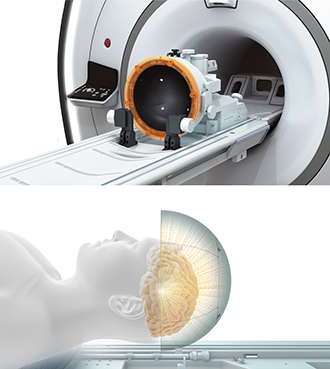Ultrasound is a century-old discovery that has been widely used as a diagnostic tool to see inside the human body, but researchers have developed new ways of harnessing the sound wave for therapy.
Despite its age, focused ultrasound technology did not gain regulatory approval as a therapy until about 20 years ago.
"Focused ultrasound is the most powerful sound you will never hear, but it's a sound that can save your life," Neal Kassell, founder and chairman of the Focused Ultrasound Foundation, told S&P Global Market Intelligence in an interview. A professor of neurosurgery at the University of Virginia School of Medicine until 2016, Kassell formed the foundation in 2006 to promote the development and adoption of focused ultrasound.
Focused ultrasound differs from ultrasound therapy, which uses vibration to apply heat to relieve musculoskeletal ailments such as tendonitis or lower-back pain.
Focused ultrasound targets the thalamus in the brain in patients with essential tremors. |
The technology deploys multiple beams of ultrasound waves, concentrated through an acoustic lens to converge at a single point of contact. This noninvasive procedure allows the high-energy beams to hit a specific target in the body, without having to make an incision like in conventional surgery.
1st adopter
China was the first adopter of the technology. In 1999, the China Food and Drug Administration approved focused ultrasound to treat a number of cancers, according to the foundation. Currently, nine of the 12 manufacturers of focused ultrasound devices in Asia are based in China.
"Much of the fundamental research and development came out of Chongqing University and other universities," said Kassell, adding that the large pool of patients available and Beijing's support for focused ultrasound helped give rise to the technology in the country.
In the U.S., focused ultrasound has also been gaining traction, with a number of conditions being approved for treatment. These include uterine fibroids, approved in 2004; pain from metastatic bone cancer in 2012; prostate diseases in 2015; and essential tremors in 2016.
The technique can be used to produce a number of biological effects at the target, such as destroying tumors, directing drug molecules to the site, or stimulating the body's immune response.
"There are so many ways ultrasound can affect tissue that it creates the opportunity to treat a whole variety of serious diseases," said Kassell.
Disruptive tech
One example is its application in essential tremors, a prevalent form of movement disorder affecting up to 3% of the global population.
Characterized by the uncontrollable shaking of different parts of the body, current treatments include taking antiseizure or anti-anxiety drugs to alleviate the symptoms, though some patients may not respond to the medications. The effectiveness of the drugs also tend to decline over time.
The other option, a surgical procedure called deep brain stimulation, involves implanting electrodes at the thalamus — the part of the brain controlling and coordinating muscle activity — attached to wires that connect to a pacemaker placed in the chest. The device sends electrical signals to the thalamus to block its signals that cause the tremors.
However, this invasive approach increases the risk of infection and patients have to undergo surgery to replace the pacemaker battery every few years.
Using focused ultrasound, the nerve cells causing the tremor can be destroyed without any surgical incision.
"Focused ultrasound is a disruptive technology, completely changing surgery as we know it today by treating with soundwaves instead of a scalpel," Israel-based InSightec Ltd. CEO Maurice Ferré said in an email.
In January, the privately held medical device manufacturer raised $150 million through a series E financing round, the largest amount raised in the field to date. Koch Disruptive Technologies, a subsidiary of privately held Koch Industries Inc., led the round with $100 million.
"Incisionless surgery reduces or eliminates many of the risks associated with surgery, such as infections, a leading cause of hospital readmission," Ferré said.
Focus ultrasound also helps free up hospital beds as patients recover far more quickly than with traditional surgery, often going home the same day as the procedure, he added.
According to the Focused Ultrasound Foundation, the technology is being studied as an option to treat about 100 different medical conditions, with 23 having achieved regulatory approval in different countries.
Despite its broad potential, focus ultrasound "is not a silver bullet, and it's not a panacea," said Kassell.
"There are certain disorders where we know it has no role. In leukemia, it has no target."
The next step is to discover the conditions for which focused ultrasound has the best chance to become a new therapy that can improve outcomes and decrease costs, Kassell said.
'Beginning of inflection point'
With the increasing adoption of focused ultrasound and regulatory approvals for its therapeutic use for various diseases, Kassell believes the field is on the verge of exponential growth.
"It's early stage but in this type of field, progress occurs exponentially and we are just at the beginning of the inflection point of the curve where in the next five years it will take off," he said.
According to the Focused Ultrasound Foundation, the number of conditions being studied has doubled between 2012 and 2017, while the number of treatments with focused ultrasound also saw steady growth. In 2016, the total number of treatments surpassed 170,000, up from about 90,000 in 2014.
"The time is now for focused ultrasound — we are on a major growth trajectory," Ferré said.
"The overall trend in healthcare is moving toward less-invasive treatments so that patients can leave the hospital quickly and get back to their lives; focused ultrasound fits perfectly into that trend."
The number of conditions for which the technology is gaining regulatory approval and getting reimbursed by insurers is increasing rapidly, said Kassell.
"We think certainly by the end of 2018, [tremor from] Parkinson's disease could be approved."
 |




